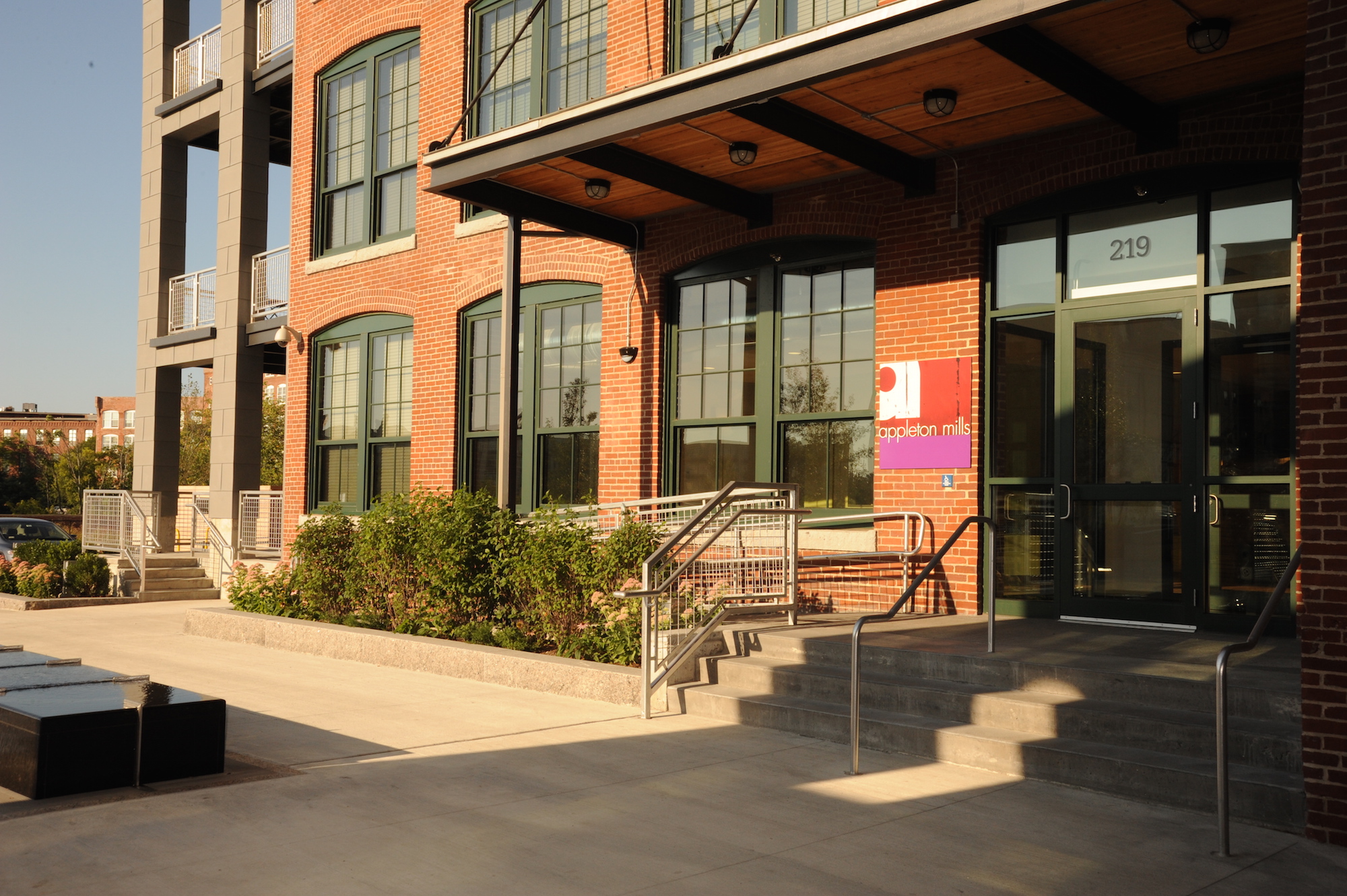Dotted with 19th century-era textile mills, Lowell, Massachusetts, houses a unique historical district and Urban National Park dedicated to the preservation of the town’s role in the New England industrial revolution. Throughout the historic district, the old buildings are undergoing a rebirth, as savvy developers undertake massive renovation projects to put the timeless façades to new uses without sacrificing the beloved character. For the Appleton Mills project, glulam beams were a key ingredient to achieving that goal structurally, aesthetically, and safely.
The Appleton Mills complex includes 5 million square feet of space, with an original structure built in the 1870s and another building added in 1906. When the developer took on the project with a goal of creating live/work lofts for artists, it had been abandoned for about 20 years and was leaking in areas where the roof was missing; nearly 40 percent of the floors had collapsed from rot. As a result, the structures had to be completely gutted, including the framing, down to just the existing 3-foot-thick brick walls.
The original building relied primarily on 12- to 15-inch-thick southern yellow pine (SYP) heavy timbers, spaced 9 feet on center, and SYP decking at a minimum 3 inches thick to carry the load of the building plus the textile-production equipment and people inside. The timbers couldn’t be saved—the wetting and reheating cycles due to two decades of exposure had deteriorated them beyond repair—and the developers were required to replace them with wood to meet historic regulations.
The design team turned to glulam, which the National Park Service determined was a suitable replacement for the heavy timbers that can no longer be found. APA member Rosboro provided 2-1/4-inch-by-21-1/2-inch glulam for the floor deck. An alternative tongue-and-groove decking would have taken a longer time to build up on every floor.
“The glulam planks were integral to building the structure on schedule and safely,” says Matt Bagedonow, vice president of CWC Builders, noting that the glulam allowed the team to maintain temporary steel bracing for the existing walls and remove it as the new floors were added, incrementally increasing the lateral stability of the walls until they were fully braced by the new floors. In addition, installers used the glulam planks to create a platform to work as they built upward. “Also, structurally, we have to provide a diaphragm action for the floor; we were able to prove we could do that with the planks by screwing them together. Glulam was really key to getting this project done. It was indispensible.”
Along with the floor system, CWC used glulam for all of the girders and floor beams, as well as to replace 8x8 heavy timber columns in the older building. “The glulam allowed us to replace the heavy timbers while still meeting historic requirements,” says Bagedonow. The industrial-grade beams were stained and left exposed in the 12- to 13-foot ceilings; in some of the 125 units, the floor decking above is also visible. “They look terrific,” he adds.
In the second building, CWC was able to salvage, sandblast, and reuse the existing cast iron columns.
Modern Meets Historic
Because of the significant scale of the remodel, the design team created a full model of the building in Revit. Like a steel building, each wood beam was numbered to produce a complete cut list for lengths. Even with that precision, however, some on-site cutting was required because the original structure wasn’t completely plumb.
Along with the building frame, similar historic provisions had to be met with walls and fenestration, including new aluminum windows that replicate the look of the originals. For unsalvageable portions of the façade, CWC located a brickyard south of Boston that uses the same clay as the original brick, allowing the team to replicate the look and color to maintain a seamless look throughout the exterior. Tuck-and-point installation ensured a quality appearance while also helping to keep water out.

Despite the historical nature of the building’s appearance, modern amenities abound inside, including an efficient heat pump system, modern appliances and kitchens, sound-abatement strategies, and a green roof.
The juxtaposition of old and new, of textile and technology, is quite fitting for the eclectic mix of residents and the greater Lowell community, which has become a center for art and music festivals. Along with attracting artists from far and wide, Appleton Mills has been recognized with national design awards.
For more resources on wood in commercial design, including technical articles and case studies, visit APA Designers Circle at www.apawood.org/designerscircle. An online community for architects, engineers, and other members of the commercial building industry, Designers Circle provides timely information, technical resources, continuing education, and recommendations for innovative wood-frame construction.
More from Author
Mark Halverson | Oct 26, 2016
Compelling conversations about wood: East and West Coast regional challenges
Fast-rising designers Ben Kasdan and Blake Jackson offer candid perspectives from both coasts on the merits—and challenges—of designing with wood and compare notes on how architects can change perceptions by dreaming big and pushing boundaries.
Mark Halverson | Oct 13, 2016
Engineered wood provides sustainable options, cost savings, and design flexibility
Designers choose engineered wood to deliver strength, stability, and a sustainable solution for complex structural designs
Mark Halverson | Jul 21, 2016
Economical, energy-efficient roof assemblies
Not all roof and ceiling assemblies are created equal, especially when it comes to energy performance.
Mark Halverson | Jul 5, 2016
Takeaways from 2015 Texas tornadoes: Construction details make a difference
Stronger building components combined with more intentionally constructed connections can mean the difference between buildings that withstand tornadoes and those that don’t.
Mark Halverson | Nov 20, 2015
Schooling the visitor
Exposed glulam and other engineered wood products help WSU tell its technology story
Mark Halverson | Aug 25, 2015
Engineered wood helps meet booming demand for multifamily projects
Multifamily housing starts reached 358,000 in 2014, a 16 percent increase over 2013 and the highest total since 2007
Mark Halverson | Jun 30, 2015
Which Is More Efficient: Wood Walls or Steel and Masonry With Continuous Insulation?
By nature, wood has nearly four times the thermal resistance of steel or masonry
Mark Halverson | Jun 5, 2015
Exposed glulam framework offers quiet complement to Jackson Hole airport’s mountain backdrop
A three-phase expansion and renovation, which began in 2009, nearly doubled the size of the aviation hub; the only one located in a national park
Mark Halverson | Jan 2, 2015
Case studies: Engineered wood brings cost savings and design flexibility across commercial project types
For commercial architects facing increasing pressure to design innovative structures while simultaneously cutting costs and accommodating tight deadlines, engineered wood systems are providing a welcome solution. With the abilities to span long distances and support increasingly greater heights, engineered wood and wood structural panels deliver performance and versatility alongside familiarity, availability and affordability. SPONSOR CONTENT















